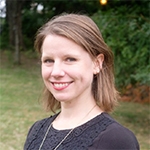
Dr. Sarah Johnson is the CEO of Teaching Lab. She is passionate about strengthening outcomes for students by improving professional development for teachers. Teaching Lab strives to fundamentally shift the paradigm of teacher professional learning for educational equity. Sarah has a wealth of experience as a former classroom educator and leader at the New York City Department of Education and the Overdeck Family Foundation.
As part of our Hop, Skip, Leapfrog interviews with subject-matter experts across the K-12 field, we asked her to weigh in on education opportunities in a post-pandemic world around professional learning. Read on for three big ideas from our conversation, in Dr. Sarah Johnson’s own words.
Takeaway #1: Virtual professional development has opened doors for increased flexibility, access, and an extended community for educators.
“Since the onset of the pandemic, we shifted to be a 100-percent virtual organization. We’re delivering professional learning to thousands of educators across the nation through a learning management system, and [we’re] using Zoom and video technology. Similar to teachers who had to shift very quickly to do that with students, [we’ve] had to shift very quickly to do that with teachers – and we do think that is something that’s going really well. We’ve even [found] that some teachers like the virtual professional learning even more than the in-person professional learning because it’s more accessible, [and] they can build community outside of their immediate school. We can create shorter chunks of professional learning that can be integrated more authentically into a teacher workflow – that’s really exciting.
We were a 100-percent in-person organization, so we would hire locally in places where we work. We would also fly in expert professional learning facilitators to support groups of teachers in building their content and pedagogical content knowledge. We have a core model at Teaching Lab that we call ‘Head, Heart and Habits.’ We’re very serious about the ‘heart’ part, which [involves] building really strong relationships between us and our teachers, but also more importantly, building these strong teacher professional learning communities. There’s actually research that shows the strength and density of teacher social capital actually translates into improvements in student learning. It’s not just a ‘nice-to-have.’
Because of that, the in-person work was incredibly important to us, and we thought that perhaps we could only do that in person. Right after we shifted in April and May, our data showed that teachers didn’t think we were building as strong of virtual communities as we were pre-pandemic. But a few months after that, we saw the data [show] that 90 percent of the teachers in our session thought that we were building just as strong of a community in a virtual setting as [it would have been] in person. It’s a huge deal and makes a huge difference for us. [It] has shifted our mindsets … around what we think we’re able to do with teachers in an online setting – what they like about it is that it’s more accessible for them. Most teachers are women; a lot of women also share a lot of duties related to raising children, [for instance.] We’ve heard from a lot of teachers that it is just easier to attend virtual professional learning.
Teachers like that they could have an hour-long planning session with us that’s immediately relevant to what they’re going to do that week. Whereas before, if we’re flying somebody in, it’s really hard to access our chunks of time. We always want to have a longer period of time with educators, so we’ve been able to increase the touchpoints that we have with teachers, which they find to be more supportive.
Finally, the last piece of feedback we’ve received is that teachers – especially in smaller districts or in districts where there are only a handful of [subject-specific teachers] – really love connecting with other teachers and other systems because it increases the professional network that they have access to. We don’t think we’re ever going to go back to a fully in-person model. We will always have at least a blended model.”
Takeaway #2: Learning Management Systems (LMS) are just as valuable for adult learning as they are for student learning thanks to functionalities that organize content and collect data – and they don’t have to be expensive.
“We had actually already done the research around which [LMS] would work for us, and then w … accelerated the adoption and building of this … open-source [LMS]. There’s so much open-source … code that all we had to do was hire a developer-consultant to help us [create] everything we needed to deliver [a] pretty exceptional professional learning [experience] to teachers. Is it perfect? No. Are there … enhancements we want to make? Absolutely. We don’t have adaptive software yet, although that’s on the horizon, but we are able to collect millions of data points, and we are connecting those data points to the other data we collect about teacher content, knowledge, mindsets, and shifts in student learning.
We’re able to do all of that right now with a pretty low amount of resource investment. I think that’s something that has been demystified for us during this time, [but] I don’t know if everybody understands that. The real investment is the time investment that my team has put into designing strong virtual professional learning courses. That is significant. That’s what the whole organization has done, but the actual technology is not that expensive and not that hard to put together. We should be paying for that smart thinking work, rather than paying a ton for [expensive] enterprise-level software [that] doesn’t give you flexibility.
We invest a lot of our money in our instructional designers, but we didn’t spend a ton of money on technological development. Again, we’re shifting a little bit right now because now we have a MVP (minimum viable product). We do have [a] vision for all these amazing enhancements we want to make, but the data shows that the people love our professional learning without it being embedded within some kind of complex, expensive platform.”
Takeaway #3: Effective instruction requires a strong foundation that is connected to students’ context
“I really like Atul Gawande and The Checklist Manifesto. He writes about how there was a time when doctors [were] doing knee surgery in their own individual way. Then, they realized that if you follow [a specific] protocol for knee surgery, you would actually increase the quality [of] outcomes of knee surgery. To me, that doesn’t deprofessionalize what it means to be a doctor. Actually, it professionalizes what it means to be a doctor. There are all kinds of ways that [a] doctor could still innovate on top of that established knowledge.
At Teaching Lab, that’s what we are constantly trying to do. We do not pretend there isn’t a foundation for knowledge and teaching. Is there a foundation of knowledge related to how we should teach kids how to read? Absolutely. We should ensure that every single teacher has access to that foundation of knowledge. The way that we do that at Teaching Lab is [by making] sure that every teacher has access to an evidence-based curriculum. Once you start the work with that kind of foundation, then you can start to innovate on top of that.
We sometimes call our model the American version of Japanese lesson study. [We help teachers] engage in cycles of inquiry. They need to be about things that teachers can control and are connected to their context. For instance, we will do cycles of inquiry around how to get evidence-based reading practices into use, but the teachers will figure out how to do that – how to enact those practices and connect it to their local context.
We’re seeing a lot of really interesting innovations happen at the instructional core. In the shift to remote instruction, we’ve seen a lot of teachers embrace what was called the station rotation model. I don’t really hear teachers calling it that when they do it in a remote way, but they are doing it more. I’ve seen a lot of teachers embrace a combination of Tier-1 curriculum, but then also tech tools that students can use to engage in independent practice while teachers spend more time with [them] in small groups. There are a lot of challenges in planning that really well. But in a remote setting, it’s almost essential because it’s essentially impossible to engage 20 to 30 kindergartners in a Zoom class for four hours at a time. You have to start integrating more small-group time. I have been shocked at how well a kindergartner can engage in some of that independent work when it’s planned really well and coherent with what the teacher is doing in whole-group and small-group instructional times.
We’re also supporting teachers to engage in that kind of planning, but through a cycle of inquiry where they’re … testing what works and what doesn’t, and then sharing that knowledge. That has been incredibly heartening – we’ve seen some really exceptional teacher innovations happening in that area. It’s not just about innovation. It’s also about … teacher empowerment over testing something out and collecting data to see if it works. We’ve seen teachers also get re-energized by that during a difficult time.
We’re also doing a lot of work now with teachers where we … help them embrace culturally responsive-sustaining education (CRSE). There’s … a lot of professional [discretion] and choice there around how you use CRSE – for example, what connections you make for students, how you build student relationships, how you bring in a student, [how you address the] cultural [foundations] of knowledge into the work, [and more.] The big thing [to understand] is [that] you can’t divorce the content areas from the framework and foundation.
I like culturally responsive teaching frameworks, because if you look at the definition by Zaretta Hammond, it’s very holistic. Teachers need to understand the cultural backgrounds of students, the cultural knowledge that they’re bringing. They need to form strong relationships. It’s not [something like,] ‘OK, we talked about the science of reading. Now let’s talk about CRSE.’ … It has to be an integrated approach.
There’s a whole world, I truly believe, within each little classroom. That’s 30 different personalities, 30 different backgrounds, [and] … a wealth of information there. There [are] a thousand micro-choices a teacher makes over the course of the day. We’re trying to help them access the professional foundations of knowledge and then, within that, engage in cycles of inquiry that are directly connected to their local context. You should understand why you would engage in this practice over [that] practice. We provide that knowledge and then support teachers in engaging in continuous improvement.”
For more insights about remote professional development, explore these additional blogs:
- With Remote Professional Development, The Opportunities Are Boundless
- How can we help? 5 ways to shift in-person PD online
- Are GIFs the Secret Sauce to Learning and Working Remotely?
This blog is one in a series describing interviews from TLA’s Hop, Skip, Leapfrog project. Explore more resources.

